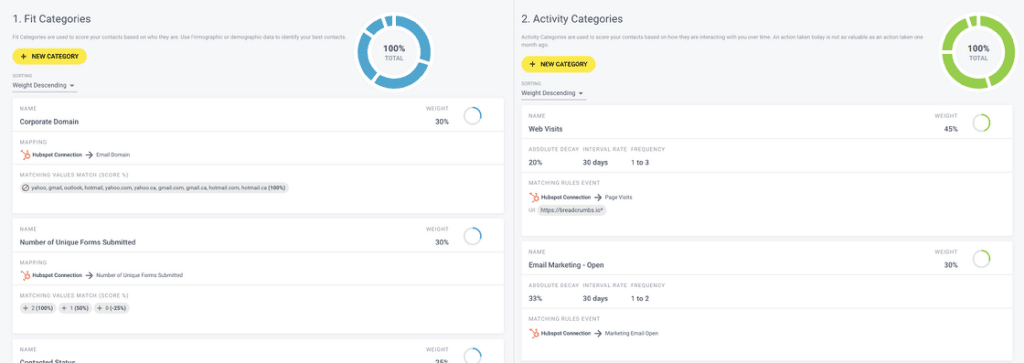Lead scoring can tell you a lot and help your team successfully identify high-value sales opportunities throughout the entire buyer’s journey… but it’s only as good as the lead scoring models that you’re using.
Every business is unique. Even if you have a competitor offering a similar product, you may target a different ideal customer profile (ICP), have a different buyer’s journey, have different pain points to overcome, and have different key performance indicators (KPIs). That means that your lead scoring models will need to be unique, too.
So, when you want to build a lead scoring model, tools like Breadcrumbs will ask a few essential questions to learn more about your business and then make model suggestions. Customizing those models, however, is completely up to you.
Ready to build lead scoring models that actually work for your business? Let’s go over the five essential rules to building scoring models that you should be following.
The 5 Rules To Building Your Scoring Model
I know, I know. Everyone out there has “five rules to accomplish [insert task here],” and most of them are generic or purely anecdotal at best.
This post is a little different. We’ve created these five rules after analyzing thousands of lead-scoring models across all industries and company sizes. And while every company (and their lead scoring models) will be different, these five rules always hold true.
1. Fit + Activity = 🏆
Lead scoring has a bad rap because most tools have a tendency to look at either fit or activity… but you really, really need both.
For reference:
- Fit defines the “demographic” or firmographic qualities of your clients that determine how closely they align with your ideal customer profiles (ICPs). Examples may include the company industry, size, annual revenue, or the job title of the contact you’re working with. Fit is an important part of the equation.
- Activity defines what actions a lead has taken with your business. Have they signed up for an email list? How often are they using the free trial? What pages are they visiting on your site? Have they filed a support ticket? All of these factors play an important role in telling you which leads are high intent and which aren’t.
Have both a fit side and an activity side for your model. It matters not only who your prospects/customers are but also how they engage with your brand and product.
Keep in mind that even today, most scoring models tend to over-index on fit. Sure, identifying your ideal customers is important, but it’s equally important to understand when they’re ready to buy and to be able to spot those signs. Especially since a good lead scoring tool will actually act as a contact scoring tool, and you should have models in place to identify high-value sales opportunities like upselling and cross-selling, too.

So, as Reddit would say, this is the TL;DR: Use Fit categories to identify who fits your Ideal Customer Profile, and use Activity categories to understand when they’re 🔥.
Here are a few easy wins to build your first activity model:
- Visits to the pricing page or product page
- Downloads of eBooks or attendance at webinars
- Product-led growth signals: trial signups, in-product usage, etc.
2. Keep it simple: start with 3 to 5 data points
Sometimes, simple really is better…. Especially when you’re first starting out with new lead scoring models. This will help you build a strong foundation for your models, which you can then optimize by testing different additional data points.
3-5 categories for fit and activity each will give you enough of an actual model that will give you information to start sorting out lead readiness, but it won’t bog you down with so much data that you’re unable to see what’s working and what’s not… or potentially even muddling the data altogether.
3-5 categories for each side of the model are a good start. How do you know which ones to pick? Reveal will get you started by identifying the most impactful fields/data points.
The 3-5 data points should be some of your strongest data points. There’s a good chance your team already has a solid idea of a few core data points that they know are high indicators of leads converting.
They may know, for example, that companies with at least 1M in annual revenue are much more likely to convert than those under that 1M number or that users who jump straight to a demo instead of a free trial are also more likely to convert.
Talk to sales, marketing, and product teams to determine which data points you should start with and go from there.
And if you aren’t sure which fit traits to focus on, Reveal will validate the correlation by revealing your current ICP. Learn more about how it works here.
-
What Is Lead Scoring?
Read more: What Is Lead Scoring?Lead scoring is the method of assigning points to contacts or potential prospects based on…
-
What is BANT?
Read more: What is BANT?BANT is an acronym that stands for Budget, Authority, Need, and Timeline. It is a…
-
What is lead qualification?
Read more: What is lead qualification?Lead qualification is a systematic process utilized by businesses to evaluate potential customers based on…
3. Your fit model must align with your ICP
We’ve already started talking about ICP, and that’s because it’s so important. It’s so important, in fact, that we created Reveal to help our clients quickly identify what their current ICP looks like.
Aim for a 60%+ hit rate with your ICP match; you can achieve this by looking for data in more than one field or by having overlapping categories.
Once Breadcrumbs has scored your leads for the first time, ensure the model works as intended instead of missing the mark.
So how exactly do you do that?
Each category should have at least a 65% hit rate, meaning that the field the system looks into has a value 2 out of 3 times. In Breadcrumbs, you’ll see this presented on one of our dashboards to show you how many contacts were scored and the percentage of hits compared to misses.

You’ll want to look at the following:
- Overall hit rate (how many contacts have a value for the properties checked)
- Rules match rate (how many contacts have the value you’re looking for)
When creating your categories, Breadcrumbs will also help you by showing core information in real-time as you type, giving you instant feedback that can inform your decisions while creating your models.
4. Your activity model must align with your customer journey
Just as your fit model must align with your ICP for it to be successful, you also need to have your activity model in line with your customer journey.
This is why personalized, custom-to-you lead scoring models are so essential. Every business’s customer journey is unique, and if your lead scoring model isn’t aligned with yours, you’ll be looking at the wrong signals.
Activity categories: they should align with your customer journey and timing that predicts conversion. Pro-tip: consider the length of your sales cycle and align to that.
Are customers more likely to convert if they view specific product pages? Or are they faster to convert (or convert at higher levels) if they sign up for a free trial or book a demo? What actions do users take right before they convert? And, just as importantly, how long does your standard customer journey take?
Your sales and marketing teams will have a strong understanding of this, so they’ll be able to give you the information that you need in order to build your starting model.
-
Lead Scoring vs Lead Nurturing: 7 Differences to Maximize Your Sales Funnel
Read more: Lead Scoring vs Lead Nurturing: 7 Differences to Maximize Your Sales FunnelManaging leads effectively means prospects move through the funnel efficiently, resulting in more conversions and…
5. Aim for 100%
The sum of all of your categories (including the “Best match” in each of those categories) needs to reach 100%.
You can have some leads go over 100% in some cases—those are leads you should absolutely pursue because they are performing high-value activities (we call them “rocket events”)—but it needs to be possible to hit that 100%.
This means the total of both fit and activity categories. If you don’t have the potential to reach 100%, you’ll flatten your scoring at the bottom end of the cohort.
The sum of your categories, as well as the “best match” in each of those categories, needs to reach 100%. You can also go over 100% in some cases.
Keep in mind that rocket events are extremely rare. That being said, when they do happen, you absolutely want to call that lead immediately. For example, prospects responding to a LinkedIn DM are showing a high level of interest. Creating a rocket event for it is the ideal way to surface that intent the moment it happens.
If you want to build a rocket, simply create a Fit/Activity category with a very high weight and a property/value setup that is rare. This will help you identify those high-value sales opportunities more accurately when they do appear.
[BONUS] It’s okay to be negative… sometimes!
Fit or activity categories should not always attribute a positive score to the lead.
In most of the scoring models I’ve built, there’s at least one category that assigns a negative score to de-prioritize a lead:

Here’s an example: Here at Breadcrumbs, we have a free email verification tool. This is designed to work as a lead magnet while offering value to our target audience. We actually use this tool ourselves to screen new leads.
This is an “activity” in our own lead scoring models. I have a fit category that will assign a negative weight to users with an invalid email address so that our sales team doesn’t bend over backward, wasting our time on them.
Similarly, I reduce the score for users signing up with a free email account instead of using a work email. This works very well for B2B companies.
A general rule of thumb: Don’t focus only on who your best customers are. It’s equally important to filter out your worst customers, and assigning negative attributes can provide clarity to make sure that the leads you’re pursuing most aggressively are the ones you should actually be focusing on.
How to Build A High-Performing Scoring Model: Wrapping Up
Lead scoring models are only as good as the data points that you’re focusing on, which is why starting with 3-5 data points that align with ICP and your customer journey is crucial to success. You can always add more data points later on and run split tests to determine which models are most effective (we can help with that!), but starting with a good foundation is key.
Want to see how lead scoring can help your business? Book your free demo with Breadcrumbs here.



